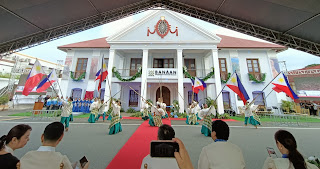Banaan
Pangasinense heritage enshrined
By Earl D.C. Bracamonte
Pangasinan's patrimony begins with the unique interactions of its vibrant communities. Pangasinense culture is, after all, built on its beautiful environs. As the country's third biggest province, it has a total land area of 536, 818 hectares. Pangasinan's territory is replete with geographical features, landforms, bodies of water, and ecological systems that also form part of the country's natural heritage.
Banaan in the Pangasinense dialect means "meeting place." Thus, it is a confluence of the influences brought by the Chinese, the Spaniards, the Americans, and the Japanese to its extensive "kabulu-an" (kingdom).
Panag-asinan which points to the Western parts of the province - the "asinan" (salt beds) of Infanta, Bolinao, and Dasul - has a lot to say about the origin of the province's name and its reputation. The province has remained the largest producer of rock salt in the entire archipelago. This aspect is extensively curated in the "Where Asin and Bolo Embraced" gallery - where its etymologies are showcased.
The province has six Congressional districts and each one operates thriving cottage industries. For instance, the beautifully crafted furnitures and fixtures come from BinMaley and Lingayen. Geographically though, after 1903, the western part of Zambales was transferred to Pangasinan. All of the six districts are featured in "The Shape of Our Homeland" gallery.
The provincial government of Pangasinan formally launched the Banaan provincial museum a few days before it was opened to the general public for viewing. As the first-ever storehouse of the province's colorful past and its diverse culture and arts, it is housed in the historic Casa Real near the Lingayen Municipal Hall.
"This is the first project that's inaugurated from several in the pipeline. The province continually fund projects such as this one. It is easy to raise up edifices, but if we don't enshrine the past you'll lose it all," intoned Hon. Ramon Guico III, provincial governor of Pangasinan.
"Since Casa Real could not house everything, we could re-open the old provincial jail and, maybe, convert it into a hotel. Perhaps, there are interested parties who may want to spend a night therein. But, kidding aside, there are plans for all our old government buildings," he added.
The museum's many galleries harken back to the days of Princess Urduja, the Galleon Trade, American colonialism, and World War II. Several artifacts, artworks, art installations, and interactive features are featured therein.
"Built circa 1940, Casa Real was the province's former capitol before it became a school and a court in different time periods. It was restored in 2017 with machuca tiles (reproduced from fiberglass from the original tin tiles coming from Belgium) and ornate ceilings, and is now the repository of Pangasinan's identity. Industrialization poses a hazard/problem to the propagation of cultural patrimony and heritage preservation. Without witness and memory, identity is lost through the passage of time. Technology too, for that matter, because we still haven't uploaded enough culture & heritage content on the Information Highway," intimated Emmanuel Franco Calairo, chairman of the National Historical Commission of the Philippines, in his keynote speech as guest-of-honor during the ribbon cutting ceremonies.
One of the interesting showrooms of the museum is the Asin Gallery. We were informed during the tour that it will showcase different exhibits throughout any given year. At the moment, it features the works of local artists and Pangasinense living abroad in an exhibition simply dubbed "Kaluyagan" (kababayan). This is a space for creative expressions and innovation, as well as historical and cultural discussions.
Another room features the province's flora and fauna, including the Asian palm civet (mustang) that turns ordinary coffee beans into highly-coveted gourmet coffee after it exits its system. The "Watered by the Hands of Ama-Gaolay" gallery is replete with scenes of its land & people, while "The Descendants of Apolaqui" gallery presents facts about pre-history, archeology, as well as myths & deities.
The "History & Development" gallery talks about patriots and nation builders. Moreover, the"Beachhead of Valor" is a microcosm of traditional life. And not to be overlooked is the "Pilgrims Who Responded to the Call" gallery which show the spiritual life of devotees to Our Lady of Manaoag.
Banaan, the Pangasinan provincial museum, was conceptualized and built under the administration of Gov. Ramon V. Guico III and the 11th Sangguniang Panlalawigan lawmakers. Visit to the museum is free for the entire month of September as tourism month. Subsequent visits may be booked via online reservations through its Web site, https://seepangasinan.com.












Comments
Post a Comment